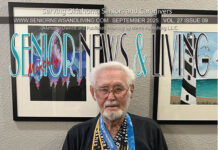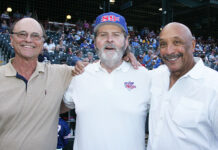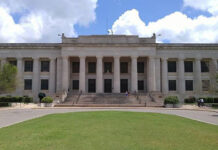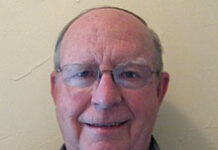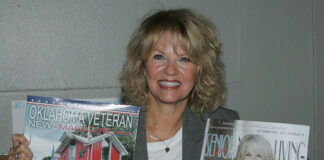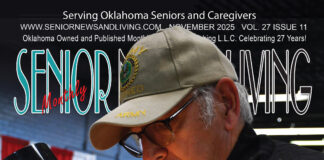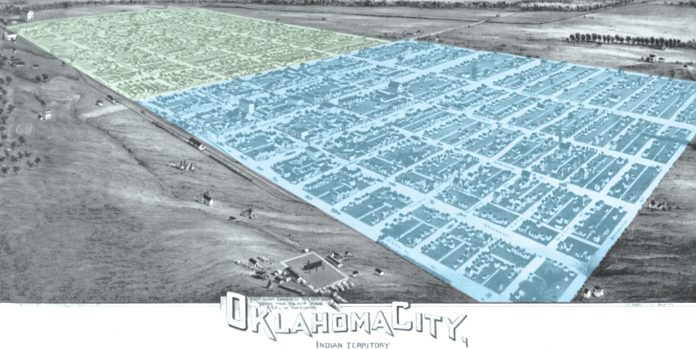
Story by Darl Devault, Contributing Editor

Many seniors have read that Oklahoma City was built in a day, although historians will tell you that many facets of its rich Western Heritage have not been brought forward to today. That could not be truer than what is commonly thought of as Oklahoma City’s history.
“The world can find the real story of Oklahoma City online at The First Eight Months of Oklahoma City (okgenweb.net), which provides a factual account of the birth of Oklahoma City in its two halves,” said Larry Floyd, 69. The adjunct U.S. history teacher at OSU-OKC said in an interview, “Research often bears out far more detail and sometimes a more surprising history than what gets published in popular accounts of any historic event.”
Although more than 50,000 settlers swarmed into the 2-million-acre “Unassigned Lands” of central Oklahoma Territory during the land run of April 22, 1889, Oklahoma City was not built in a day, month, or even a year. (story continues below)

Most future Oklahoma City residents came in by train to the Oklahoma Station townsite, arriving from the north and the south. The train coming north from Purcell was one hour late to the central depot for the three largest railways in the Southwest: Rock Island, Katy, and Santa Fe.
Because of this Oklahoma City began as two cities. Soon known as Oklahoma City and South Oklahoma City, this instant Western heritage was energized by people seeking the last of the free land folks had moved west to settle. Part of that heritage was the abundance of land, a fact that complicated the city’s beginning.
Many settlers wanted to claim their 160 acres while living close to the new townsite since it featured transportation and water as the North Canadian River ran through it. The 22 packed railroad cars arriving an hour late from Purcell brought new residents to a townsite already filled by hundreds of new Oklahoma Cityans. They had already staked their claims after arriving first on the train from Guthrie.
Oklahomans have consistently proven themselves resourceful, so the late arrivals set about creating South Oklahoma south of the Oklahoma City townsite. For every description of people staking claims and securing lots, the same took place on a prairie south of Reno Avenue in the new South Oklahoma City.
When G.W. Patrick found the most desirable lots taken and unable to do any better, he staked two lots on the south side of block three. His fellow late arrivals from the train followed his lead.
On April 23, Patrick began surveying south from the section line at Reno Avenue as the Citizens’ Survey began working north. Encountering no conflicting surveys, Patrick’s crew laid out 35 blocks along seven streets, and settlers made adjustments as required.
By Saturday, April 27, the citizens of South Oklahoma elected Patrick mayor and a full slate of city officials. They also drafted and adopted a city charter. Oklahoma City to the north elected Capt. W.L. Couch as mayor on May 1.
According to the City Directory published by the Oklahoma Chief newspaper in August 1889, South Oklahoma contained approximately 1,300 residents compared with about 3,700 north of Reno Avenue in Oklahoma City. The commercial district was mainly in Oklahoma City (except for the south side of Reno Avenue) and was the most densely developed portion of the two cities.
During the 15 months of its separate existence, South Oklahoma City saw three months of public schools, two churches, construction of an ice factory, lumberyards, and hundreds of homes built.
On May 2, 1890, the U.S. Congress passed the Organic Act, which provided for the organization of Oklahoma Territory and governing municipal incorporation. A petition was accepted on July 15, 1890, consolidating Oklahoma City and South Oklahoma into Oklahoma City.
This info is available online at https://www.89ertrail.com/12/# .
Capitol Hill was incorporated as a city in 1905. By then, a strong sense of community and civic activity made this area an economic and cultural force remaining independent until it joined with Oklahoma City in 1911.
The southern part of Oklahoma City continued to provide space to grow in the decade of statehood in 1907, Oklahoma City became the nation’s fastest-growing city from 1900 to 1910 and the new state’s capitol city.
Oklahoma City’s first major park, Wheeler Park, was established on the banks of the North Canadian River in 1903. The park included extensive gardens and places to relax and picnic. In 1904 the city’s first zoo opened in the park. After two great floods swept down the river in 1923, wiping out Wheeler Park, the zoo was relocated. The playground, park, and baseball diamonds were restored.
Oklahoma City’s first airport was built in south Oklahoma City. In 1911, the Oklahoma City Municipal Airfield opened the skies for future travel. The airfield brought new opportunities and visitors to the city, and in 1941 it was rededicated as Will Rogers World Airport.
Oklahoma City has since capitalized on its strategic central location from its beginning to its present status as the crossroads of America. Just like its beginning as a railroad hub, it assumed the crossroads are our nation’s two main interstate highways (I-35 and I-40). They intersect in Oklahoma City and share the same roadway for two miles. Even before the interstate highway system, OKC gained from being on historic Route 66 from Chicago to Los Angeles.
Farmer-stockmen found the city’s location along the North Canadian River strategic and its railroad services a lifeline to the rest of the country. Once the area’s largest employer, the Oklahoma City Stockyards and its business district maintain a high profile, it is a tourist destination and unofficial Western heritage center. Although no longer a focal point for local slaughterhouses, the daily cattle auctions still make it the world’s largest stocker/feeder market.
The city has cultivated its place as the centrally located Western Heritage center. It hosts more horse-related shows and competitions each year than any city globally. The National Cowboy and Western Heritage Museum is the official steward of that Western heritage. After a recent expansion, it now houses the most extensive collection of Western art and Americana west of the Smithsonian.





